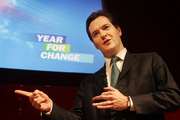 What’s at the heart of the row over defence funding? George Osborne hinted at it today when he told the Telegraph that “frankly, of all the budgets I have seen, the defence
budget was the one that was the most chaotic, the most disorganised, the most overcommitted”.
What’s at the heart of the row over defence funding? George Osborne hinted at it today when he told the Telegraph that “frankly, of all the budgets I have seen, the defence
budget was the one that was the most chaotic, the most disorganised, the most overcommitted”.
The problem is that during the Labour years, various accounting scams were deployed to shunt costs further into the future – but this was not matched by resources. So they would, for example, delay an order by two years. There would be a price to pay for this delay, but it would be a cost that came after the election so Labour didn’t mind. (One must remember that HM Treasury behaved disgracefully under Brown’s instructions, concealing debt and adopting a ‘scorched earth’ strategy).
The result is that the commitments due to come from the MoD over the next five years are about 10 per cent higher than its allocated budget. I understand that Osborne has been horrified to discover that the MoD has been running its own deficit – one that will be piled on top of the national deficit. So, for example, a cut of 10 per cent in the MoD budget (ie, a cash freeze unadjusted for inflation) would effectively mean a cut of 20 per cent – because it would have to cope with all of Labour’s over-commitments.
This is what has so complicated budget negotiations, and led to the minor explosion we saw last week. But Osborne is, like Liam Fox, committed to maintaining Britain’s role in the world. William Hague has spoken about the need to avoid “strategic shrinkage” and 10 percent cuts would translate into twenty percent cuts. Avoiding real shrinkage—the type that Philip Stephens talks about in today’s FT—would not be possible. That’s why my guess is that, like welfare, Osborne and Fox will reach an agreeable settlement. As Obsorne made clear in his remarks in the Telegraph, he understands this implications of this MoD “internal deficit”. Perhaps this Italian-style scam was the only way the MoD was able to fund five wars on a peacetime budget. But the next step should be to conduct and publish an inquiry into how these accounting fiddles were made possible and lay undetected for so long.







Comments